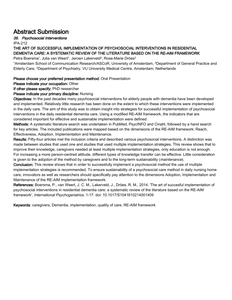Art therapy is widely used and effective in the treatment of patients diagnosed with Personality Disorders (PDs). Current psychotherapeutic approaches may benefit from this additional therapy to improve their efficacy. But what is the patient perspective upon this therapy? This study explored perceived benefits of art therapy for patients with PDs to let the valuable perspective of patients be taken into account. Using a quantitative survey study over 3 months (N = 528), GLM repeated measures and overall hierarchical regression analyses showed that the majority of the patients reported quite a lot of benefit from art therapy (mean 3.70 on a 5-point Likert scale), primarily in emotional and social functioning. The improvements are concentrated in specific target goals of which the five highest scoring goals affected were: expression of emotions, improved (more stable/positive) self-image, making own choices/autonomy, recognition of, insight in, and changing of personal patterns of feelings, behaviors and thoughts and dealing with own limitations and/or vulnerability. Patients made it clear that they perceived these target areas as having been affected by art therapy and said so at both moments in time, with a higher score after 3 months. The extent of the perceived benefits is highly dependent for patients on factors such as a non-judgmental attitude on the part of the therapist, feeling that they are taken seriously, being given sufficient freedom of expression but at the same time being offered sufficient structure and an adequate basis. Age, gender, and diagnosis cluster did not predict the magnitude of perceived benefits. Art therapy provides equal advantages to a broad target group, and so this form of therapy can be broadly indicated. The experienced benefits and the increase over time was primarily associated with the degree to which patients perceive that they can give meaningful expression to feelings in their artwork. This provides an indication for the extent of the benefits a person can experience and can also serve as a clear guiding principle for interventions by the art therapist.
DOCUMENT

Presentatie gegeven over de review in Brussel Objectives: In the past decades many psychosocial interventions for elderly people with dementia have been developed and implemented. Relatively little research has been done on the extent to which these interventions were implemented in the daily care. The aim of this study was to obtain insight into strategies for successful implementation of psychosocial interventions in the daily residential dementia care. Using a modified RE-AIM framework, the indicators that are considered important for effective and sustainable implementation were defined.
MULTIFILE

Within PREMIUM_EU we have co-responsibility for developing the Regional Development Effects Module (RDEM). This module will map the impact of migration on regional development seen on different variables. To construct the RDEM we have to:1. develop a typology of regions, based on the impact that mobility has on its economic, social and cultural development; and2. detect the causal linkages between regional mobility on the one hand and regional development on the other.In our presentation we will focus on the process to determine relevant regional development indicators that will help in the collection and analysis of relevant data for the period 2010-2022 on NUTS 2 and 3 level. Partners in our project will additionally focus on:1. Analysis of regional networks estimated from Facebook2. Building typology regional development3. Longitudinal causal analysis of mobility4. Integration of case studiesFinally, this will result in:• Online atlas of mobility & development typologies• Report Causal Analysis of mobility development
DOCUMENT

Due to their diverse funding sources, theatres are under increasing pressure to demonstrate impact on society. The Raad voor Cultuur (2023) for example advised the secretary of state to include societal impact as an additional evaluation measure next to artistic value. Many theaters, such as the Chassé Theater and Parkstad Limburg Theaters, have reformulated their missions to focus on impact of performances on visitors. This is a profound transformation from merely selling tickets and filling seats, and requires new measurement instruments to monitor, manage, and improve impact. Currently available instruments are insufficient, and effective monitoring is crucial to larger future projects that theaters are currently planning to systematically broaden impacts of performances on their communities. The specific goal of this project is to empower theaters to monitor and improve impact by developing a brief experience impact questionnaire, taking existing data from student projects conducted at the Chassé Theater about performing arts experiences on one hand, and experience impact theory innovations on the other, as starting points. We will develop potential items to measure and benchmark against established measures of valued societal outcomes, such as subjective well-being and quality of life. These will be measured in questionnaires developed with project partners Chassé Theater and Parkstad Limburg Theaters and administered before and after performances across a wide range of genres. The resulting data will enable comparison of new questionnaire items with benchmarked measures of valued societal outcomes. The final product of the project will be a brief impact questionnaire, which within several brief self-report instruments and just a few minutes can effectively be used to quantify the impact of a performing arts experience. A workshop and practice-oriented article will make this questionnaire implementable, thereby mobilizing the key enabling methodology of monitoring and impact measurement in the performing arts sector.